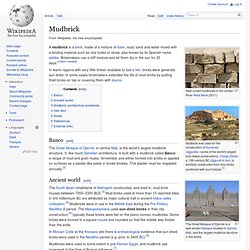

Construction material prices and labour cost in Pakistan. Www.yourhome.gov.au/technical/pubs/fs56.pdf. Mudbrick. New unlaid mudbricks in the Jordan River West Bank (2011) Mudbrick was used for the construction of Sumerianziggurats—some of the world's largest and oldest constructions.

Choqa Zanbil, a 13th-century BC ziggurat in Iran, is similarly constructed from clay bricks combined with burnt bricks.[1] A mudbrick is a brick, made of a mixture of loam, mud, sand and water mixed with a binding material such as rice husks or straw; also known by its Spanish name adobe. Brickmakers use a stiff mixture and let them dry in the sun for 25 days. [citation needed] In warm regions with very little timber available to fuel a kiln, bricks were generally sun dried. Banco[edit] The Great Mosque of Djenné is a well-known Mosque located in Djenné, Mali, and the largest mudbrick structure in the world. The Great Mosque of Djenné, in central Mali, is the world's largest mudbrick structure. Ancient world[edit] Mudbrick architecture worldwide[edit] See also[edit] Notes[edit] References[edit] Possehl, Gregory L. (1996).
Sustainable Buildings, Earth Friendly construction, Mud brick construction and alternative building materials. There are a range of sustainable building materials that are both Earth friendly and elegant at the same time.

Mud brick and poured Earth construction techniques are just a few of the options available for earth friendly construction. Building with alternative materials can be a challenging but ultimately rewarding adventure. Below you'll find some some tips, advice and information to consider if you're thinking about embarking on a energy efficient building project that involves sustainable building materials. Earth Building Mudbrick, also referred to by the Spanish name of 'Adobe' which means mud or puddled earth, generally refers to the technique of building with sun-dried mud blocks in either load bearing or non load bearing construction. Mudbrick has several advantages over conventional fired clay or concrete masonry.
Finishing of mudbrick walls can be undertaken with a variety of techniques ranging from as constructed to a simple "bagged" finish to a full set earth render. Adobe. For a deeper understanding of adobe, one might examine a cob building.

Cob, a close cousin to adobe, contains proportioned amounts of soil, clay, water, manure, and straw. This is blended, but not formed like adobe. Cob is spread and piled over the home's frame and allowed to air dry for several months before habitation. Adobe, then, can be described as dried bricks of cob, stacked and mortared together with more adobe mixture to create a thick wall and/or roof. Adobe structures are extremely durable, and account for some of the oldest existing buildings in the world. A distinction is sometimes made between the smaller adobes, which are about the size of ordinary baked bricks, and the larger adobines, some of which may be one to two yards (1–2 m) long.
Etymology[edit] In more modern English usage, the term "adobe" has come to include a style of architecture popular in the desert climates of North America, especially in New Mexico. Composition[edit] Adobe bricks[edit] Adobe roof[edit]